Representing hundreds and thousands
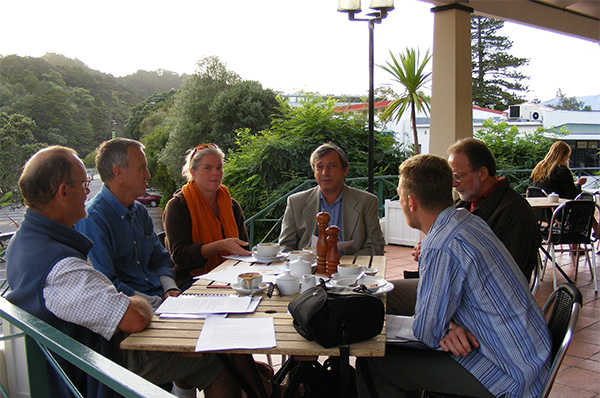
Nine Years and Counting: Riverside brainstorming breakfasts during the 2007–2009 Royal Commission on Auckland Governance process invariably pictured the Warkworth Town Hall providing the natural setting home for the Mahurangi community to discuss its issues and aspirations, and role in the greater region. None here would have imagined that, nine years on, local representation would be being described by a council consultant as a problematic ‘complexity’, to be solved by having less of it. image Sarah Ransom
On average, each of Auckland region’s part-time local board politicians represents 9500 people.
But a report prepared for Auckland Council argues for the number of local boards and local board members to be halved, which would double the number each member represented, to 19 000.
The Royal Commission on Auckland Governance saw the local representative role as being part-time only. Its argument was that this would allow fully employed people, including business owners and professionals, to undertake the role. Because the salaries paid to local board members is set by the Remuneration Authority and are dependent, in part, on the number of people represented, halving the number of local board members would push those salaries up into the category of full time.
Local board member salaries currently average $41 026, and local board chairs nearly double that. The lowest paid local board members are those representing Great Barrier Island, at $23 350, while the highest, those representing Howick, $43 450. The report—the Governance Framework Review Report —makes no allowance for the local board positions being part-time when its states that Auckland Council’s:
…most stark feature is the sheer number of elected members.
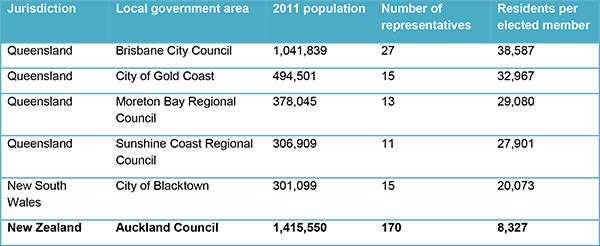
Apples and Cherries: Table purporting to ‘starkly’ highlight the ‘sheer number of elected members’ of Auckland Council compared with the balance of the ‘largest’ Australasian local body ‘areas’. But by ‘area’, it is meant individual jurisdiction. The most populous area of course is Sydney, the regional area of which will have, when governance changes currently underway take effect, 411 elected representatives, representing an average 11 270 residents each, broadly comparable to Auckland. table Governance Framework Review
The number, of course, is primarily a factor of the region’s 1.5 million population. If Aucklanders were represented at England’s ratio, they would be entitled to twice as many elected representativesEngland’s elector-to-councillor ratio is 3757.
Auckland Council councillors, in contrast to local board members, are paid full-time salaries, of $105 800, with the three heads of committees receiving $125 350, and the deputy mayor and mayor receiving an unambiguous $151 850 and $269 500 respectively. On average, Auckland’s councillors represent about 67 400 residents each, but of course share the workload with the 159 local board members.
When the royal commission recommended that the role of local representatives be part time, they bucked a trend towards the job of local body politician being regarded as a full-time job:
It is expected that the commitments of a local councillorwith the decision of the government to opt for 21 local boards rather than 6 local councils, the role became local board member will be able to be met on a part-time basis in order to encourage a broader pool of candidates to serve. Council business will need to be tailored to recognise that councillors’ time is limited, and needs to be put to optimum use.
[emphasis added]

Apples with Apples: A comparison of regions close in population to Auckland, but also including the most populous in Australia and the United Kingdom, shows that far from it being an outlier, the Auckland region has a resident-to-representative ratio only a quarter less than Sydney’s, and less than half the representation of Londoners—it is Brisbane that is the brute, with more than 28 000 residents per representative. table Mahurangi Magazine
More recently, the emphasis had been on paying a living wage to councillors, so that wage earners, for example, could stand for office. County councils of old were notoriously unrepresentative, with a preponderance of retirees and farmers, if not retired farmers—truck drivers, factory workers or shop assistants couldn’t begin to contemplate serving.
If the report’s suggestion of doubling the number of people represented by local board members was to proceed, the role would become unambiguously full time. This should be resisted until such time that the part-time-local-board-representative model is deemed to be undesirable, and that all Auckland region representation should be by full-time salaried people.
While England’s 3757 : 1 elector-to-councillor ratio might seem excessive compared to Brisbane’s 38 587 : 1, in France and Sweden, each representative represents a mere 118 and 256 people respectively. In such countries, the role is entirely voluntary, and in France and Sweden employers must allow elected representatives time off for municipal or county meetings. Such is not the case in Aotearoa, but Buller District, for example, resolved to hold its council meetings from 5 pm, to encourage younger, working people to stand for office.
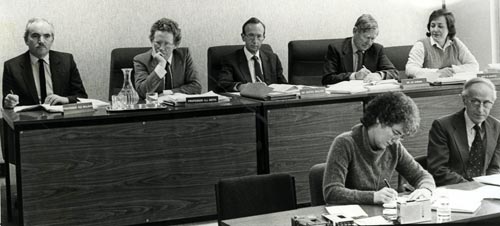
That is a Royal Commission: Not only did the Royal Commission on the Electoral System identify the reasonably practicable options for Aotearoa for electoral reform, it recommended that no change should occur without a binding referendum—a facultative plebiscite. With shameless arrogance, the Auckland governance commissioners failed to provide options, then insisted that their master plan must be implemented without alteration, and without residents of the region being given the opportunity to accept or reject the proscribed changes to their democracy. image Encyclopaedia of New Zealand
Almost regardless of what model the royal commission came up with, amalgamating Makaurau’s four city, two district and one regional councils and their respective district and regional plans was always going to take decades to bed in. Even before the 2010 mother of amalgamations, it was warned:
Indeed, numerous submitters to the royal commission cited resentments stemming from the round of forced amalgamations two decades earlier:
Despite this observation, the royal commissioners were oblivious to their own complicity in forced amalgamation. Mahurangi Action’s submission stated:
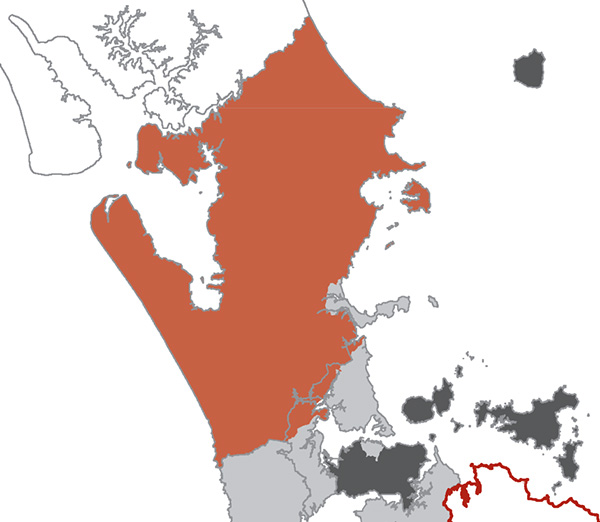
Royally Unrepresented Rodney: Under the self-confessed expedient recommended by the Royal Commission on Auckland Governance, the monolithic Rodney District Council would have been placed by a monolithic Rodney Local Council, but with only 7 local councillors, replacing the 12 councillors and a mayor that previously represented the area, which admittedly included the populous Hibiscus Coast that made up more than a third of the population. Of the options the Local Government Commission might consider, replacing the current single Rodney Local Board with a northern and a southern local board is by far the most practicable and reasonable. Meantime, no alarm should be taken from cartographic slipup that has the Mahurangi Harbour here prematurely silted up—the harbour’s geomorphological future, was it not for anthropogenic sea-level rise. image Royal Commission on Auckland Governance
At the hearing, royal commission chairman Hon Peter Salmon asked Mahurangi Action:
But don’t you consider that this provides the mandate?
This, being the royal commission process. Salmon was indifferent to the answer—which was along the lines of:
No it doesn’t; Aucklanders weren’t made aware what their options were.
—but then, nor was it a question. Equally egregious is that the status quo should always be an option, which it wasn’t, but belatedly is now, under the 2012 legislation.
It seems to be impossible to discover what the transition costs are to date, and the costs continue, given reports of a perpetual ritual of restructuring within Auckland Council and the various organisations the council controls at arms-length. Restructuring is the first and last resort of the clueless, and is deadly on morale. At a time when the community is struggling to learn how to work with the local boards of the new, shared governance model, halving the number of those boards would be horrendously unhelpful. Much of the report addresses processes that do need to be made fit-for-purpose, but strays wildly from its self-declared purpose:
The review focuses on making the existing framework work better for Auckland.
It does nothing of the sort, venturing not only into halving the number of local boards, but into introducing a central-government style mixed member proportional system of electing councillors. This is all terrifically edifying, but the time for advancing that was during the 2007–2009 royal commission, which saw no virtue in allowing preference voting, much less proportional voting. The author, by introducing so many red herrings has made the job of the seven-councillor and seven-local-board-member governance-framework-review working party doubly difficult. Rodney is fortunate in that one if its local board members, Phelan Pirrie, is a working party member.
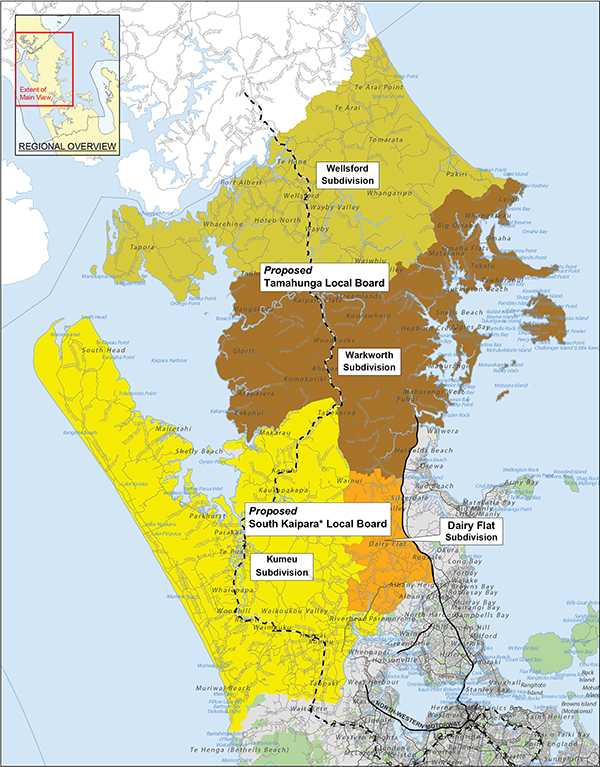
Twin-Local-Board Tweak: With the region’s new governance arrangements not yet seven years old and only just beginning to settle in, it is too soon to objectively judge their success, and far too early to begin a rebuild. The task of amalgamating four cities, two district and one regional councils was colossal, but regardless of the sin of it being imposed without due democratic process, the sooner the threat of internal and external restructuring is abated, the sooner Auckland Council will be allowed to get on with the job of serving Aucklanders—almost any structure can be made to work, if those within and without are constructive and dedicated. But since the opportunity arises, separate Kumeū- and Warkworth-centred local boards—something the Local Government Commission should have delivered in 2010—would be a simple, practicable tweak. map Auckland Council annotation Mahurangi Action
The report repeated talks of the complexity of Auckland Council’s governance model. Mostly, the author is taking aim at the shared governance model—between local boards and governing body. But tiers of governance are a necessary part of representative democracy. Carried to its logical conclusion, a single governance tier could suffice for all of New Zealand’s 4.8 million residents. But aside from the logistics, Parliament would need to house nearly 500 representatives, which wouldn’t allow one’s local member a lot of speaking time, nor local delegations many opportunities to appear before the governing body.
The government, when rejecting the royal commission’s six-local-council recommendation, provided for between 20 and 30 local boards. In the event, thanks to the Local Government Commission, only 21 boards were established. Meantime, apparently:
While fewer boards could conceivably improve some logistical dynamics, the fewer the boards the less local they become. And a reduction would require Auckland Council to make application to the Local Government Commission under the same process that has already been bitterly running for four years in respect to the wilful bid to have a unitary authority established for north Rodney’s meagre population. But compounding the reports’s unlicensed and untimely foray into the region’s democratic structure, none of this should be occurring behind the closed doors of a working party. Auckland Council exists to serve Aucklanders, it does not belong to those who happen to be its current custodians.
In Europe, local representatives look after the needs of hundreds; in the United Kingdom, thousands. The report’s preposterous proposal that local representatives should look after the needs of tens of thousands should be rejected as utterly without merit.
It’s time the meddlers within and without Auckland Council were made to desist, and the generally-genuinely-dedicated council officers allowed to get on with their respective duties, without further hindrance.
Correction The Mahurangi Magazine thanks Deputy Mayor Bill Cashmore for pointing out that the Governance Framework Review Report was prepared by Gareth Stiven working as an independent contractor. The Mahurangi Magazine had erroneously referred the report as the work of PwCpreviously PricewaterhouseCoopers, where the same Gareth Stiven is listed as ‘Director | Consulting’.
Update In early 2016, Auckland Council instigated the governance framework review discussed above. Whatever the report’s terms of reference were, if any, the wildly out-of-scope options, discussed behind closed doors, have been binned by councillors, as the New Zealand Herald aptly put it, on 25 July 2017. The Mahurangi Magazine is proud to have played a part in discrediting the report’s wildly inappropriate recommendations—the feedback from councillors already suspicious of the report’s comparisons was vindicating—but laments that the millions of dollars consumed by the abortive year-and-a-half exercise could have been spent on evidence-based measures known to increase participation in the democratic process.
